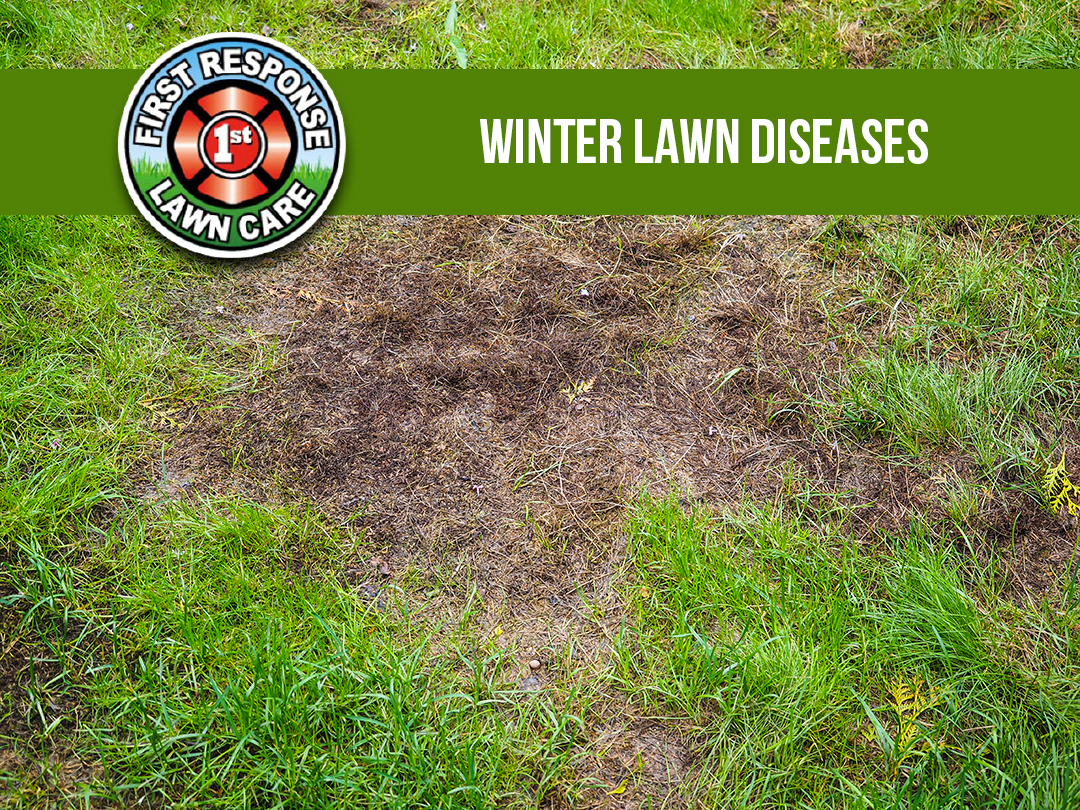
by admin | Feb 15, 2019 | Lawn Care 101, Lawn Diseases
Winter lawn diseases and what you need to know about them.
Severe damage can occur in lawns during the winter months. Sometimes patches of lawn become brown or bare during the winter and don’t return to green when spring comes around. For the most part, turf grasses are resilient and strong, though damage to grasses for Various reasons.
Cold Desiccation
Grasses will survive just about any temperature if they are blanketed with snow, but uncovered grasses in very cold conditions will continue to lose moisture and oxygen after the ground is frozen solid.
If the damage is minor, individual grasses may recover, or surrounding grass plants may fill in. With widespread damage, you likely will need to reseed or re-sod dead areas.
Snow Mold
When heavy snow falls over ground that is not yet cold, the moist conditions may foster a variety of fungal diseases collectively known as snow mold. In the spring when the snow melts, you will notice fuzzy or crusty patches, pink or gray in color, blanketing portions of the lawn.
Snow mold usually dies as sun and breezes dry out the lawn, but if the turf has been infected for a long time, the grass may die. Usually, though, the grasses will gradually recover. If the lawn still has debris from the previous year, rake this up to improve air circulation to the grass.
To prevent snow mold, make sure to de-thatch or aerate your lawn regularly, which will increase air circulation and prevent snow mold.
Crown Freeze
The crowns of turf grass can be killed if warm, moist weather is followed by a sudden freeze. This is most common in late winter and early spring, when unexpected frost occurs in warm climates.
Widespread damage requires reseeding or re-sodding. There is not much you can do to prevent crown freeze.
Voles (Field Mice)
Sometimes winter damage is caused by voles. The mouse-like pests average around six inches long, and they spend their winters tunneling beneath the snow or lawn debris, eating plant roots and keeping warm.
Re-seeding is usually the best option if the damage is not too severe. Otherwise re-sodding the damaged areas may be required. To keep voles at bay, remove dead grass and fallen leaves in the fall. Our fall or spring cleanup services might be right for you!
Questions? Contact First Response Lawn Care by clicking the link below to ask about our expert services in all these areas!
Contact First Response Lawn Care Today!
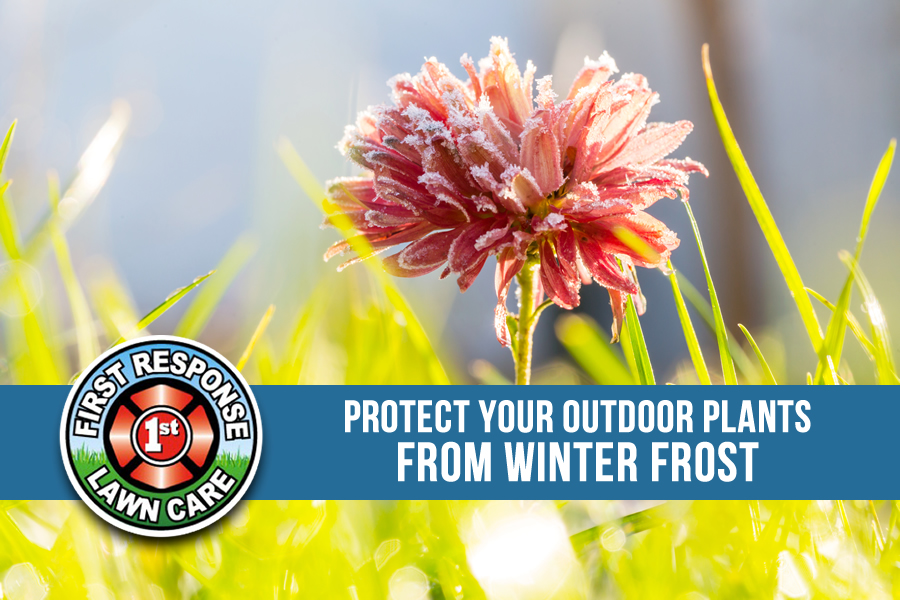
by admin | Feb 9, 2018 | Lawn Care 101
Low temperatures are being forecast for this weekend in much of Texas as a winter storm slides through the Dallas metro area. Time to talk about protecting outdoor plants from Texas frost. One day it’s 55 and sunny. The next, it’s 32 with frost on the ground. Welcome to Texas ya’all. Fluctuating temperatures are a common occurrence around here. Back to the pending freeze tomorrow. You may need to protect your outdoor plants and flowers from the freeze and/or frost.
The warmth we’ve had may be enough to keep a plant from freezing during a short cold snap. For added protection, you can protect plants in a freeze by placing a sheet or blanket over the plant and then putting a piece of plastic over the sheet or blanket to help keep warmth in. Never cover a plant with just plastic, however, as the plastic will damage the plant.
You can cover larger plants (trees and shrubs) with old bed sheets, burlap, or commercial frost cloths (avoid using plastic). For best results, drape the cover over a frame to keep it from touching the foliage.
Be sure to uncover them in the morning when the temperature rises above freezing.
Stay warm friends since the Groundhog Day rodent, Woodstock Willie, did see his shadow and predicted six more weeks of winter weather from February 2nd!
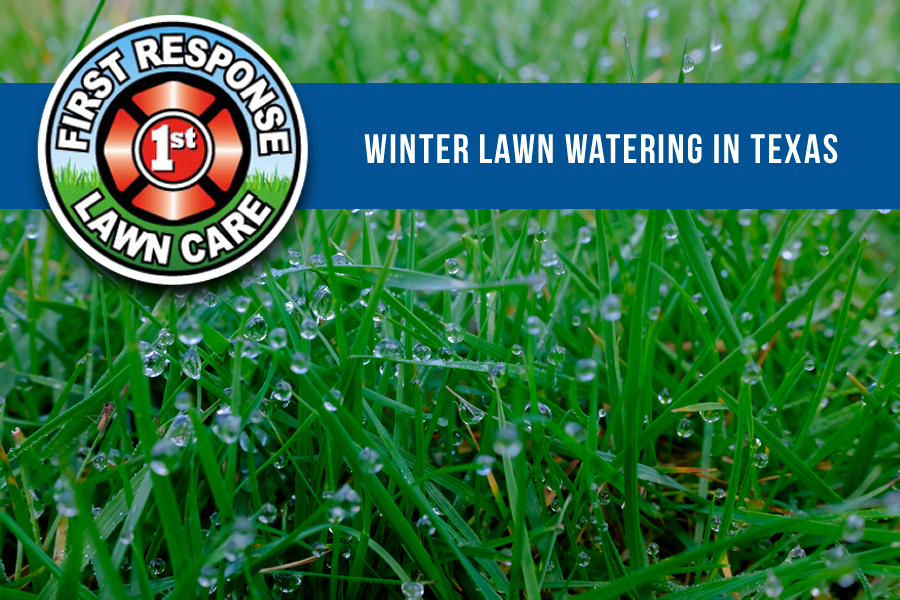
by admin | Jan 11, 2018 | Lawn Care 101, Lawn Maintenance Rockwall, Watering
The burning question this week is “Should I water my lawn in the winter”? And the answer is, “YES”! Your grass needs about 1 to 2 inches of water per week, including rainfall depending upon your type of grass.
During the periods of prolonged winter drought, if the air temperature is above freezing and the soil isn’t frozen, you should water every two or three weeks for 15 to 20 minutes – just enough to provide moisture to the crown and roots and counteract the drying effects of winter winds. Time afternoon watering so grass blades don’t remain moist overnight, which minimizes the threat of fungal diseases. If your grass is long and lush, you can try deep soaking. This allows the water to penetrate deep into the sub-soil and root zone of the grass, six inches deep. If you cut your lawn severely last fall or mow it in winter so that top growth is very short, it will dry out even faster. Even in winter, it’s best to leave your grass tall.
It’s also important to know your grass type. Cool season grasses like fescue, rye or even bluegrass do not necessarily go completely dormant during the winter months. It’s a good idea to water them every now and then when there is no forecast of a hard freeze. Texas generally has Bermuda, Zoysia, St. Augustine, and centipede grasses, which are warm-season grasses. These go dormant once temperatures drop below freezing. The combinations of warm and cool season grasses might include Bermuda and rye or Zoysia combined with fescue or rye. With all these combinations, the result is often the same – a two-tone lawn.
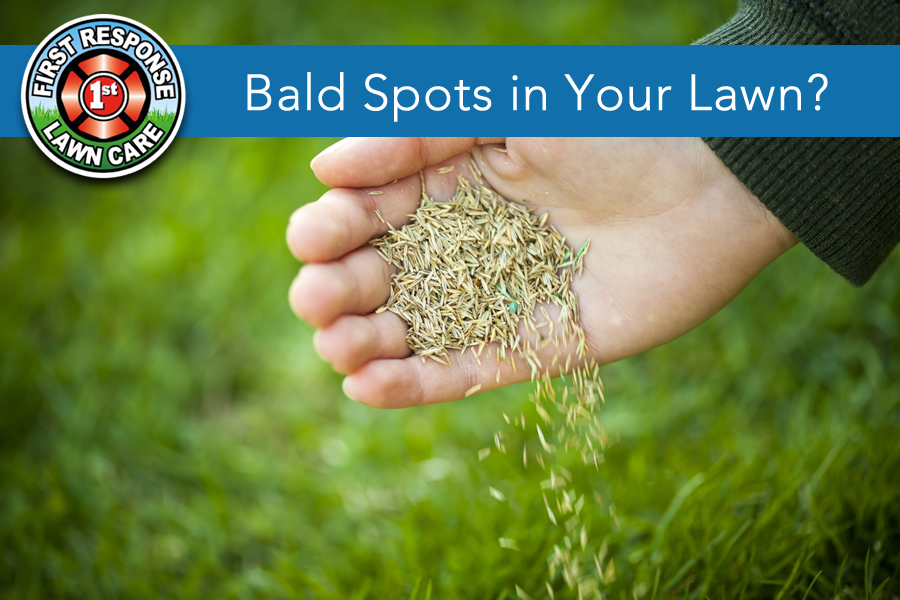
by admin | Sep 15, 2017 | Lawn Care 101
Do you have bald spots in your lawn? Before the turf can be treated, you need to determine the root, pardon the pun, of the problem. If you eliminate pests and fungus as causes, you may just find that you need some seeds.
Good seed-to-soil contact will get the seeds germinating fast. Using a sharp spade or shovel, cut the area around the dead turf. Then, use the flat part of the spade to lift off the dead turf. Because you are removing at least a couple of inches of thatch and grass, fill in the area with some clean topsoil to keep it level with the rest of the yard.
Rake out the area until it is smooth and there are no big clumps in the soil. Cast a thin layer of seeds on the area, and then gently rake the seeds into the topsoil. Cover it with straw to hold in moisture and protect the seeds from birds.
If your lawn seems thin all over, try overseeding it. The basics are the same as patching. Rake the area well, picking up any leaves and debris in the turf. Cast the seeds over the turf, and then spread about a half an inch of compost or topsoil on the lawn. To get good seed-to-soil contact, gently rake the seeds and soil into the grass.
If you don’t have time to patch your lawn, call a professional. First Response Lawn Care is here to help with your bald spots—on your lawn!
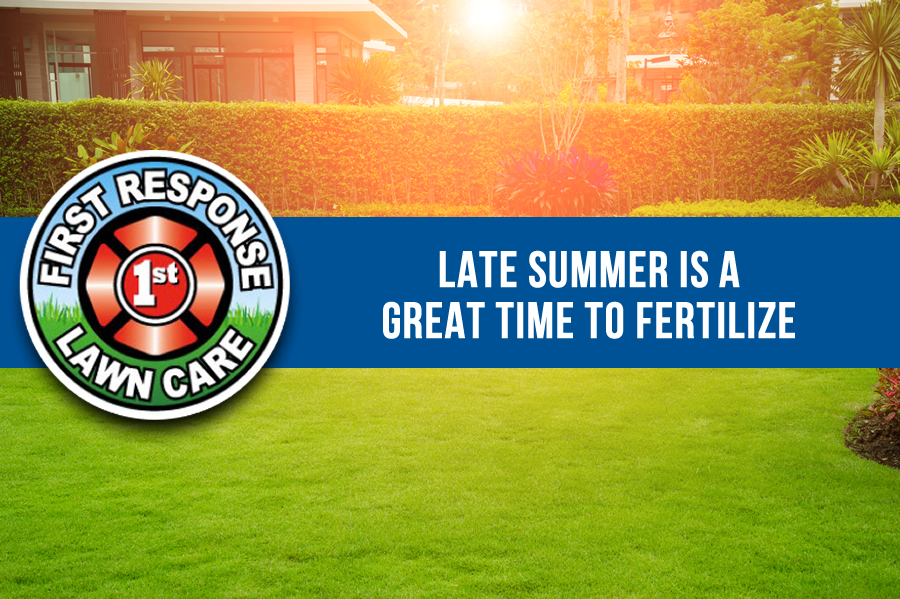
by admin | Aug 25, 2017 | Herbicides, Lawn Care 101, Texas Summer Lawn Care Tips
Hey North Texas, late summer is a great time to fertilize your lawn. Summer is tough on grass. Heat, drought, foot traffic, and insects stress it out to the max. Feeding your lawn in the late summer protects and strengthens it against these problems.
Lawns in warm-season grass areas should be fed over the summer months as they grow steadily from spring to fall. If you see insects in your grass, it’s time to also incorporate insect control.
In the late summer and early fall, root growth begins again because of the decrease in soil temperature and increase in natural rainfall. The grass will green up again with the production of new roots and shoots and damaged patches will start to disappear. Fertilizing at this time will provide the nutrients the grass needs to recover and re-grow rapidly.
The fertilizer you apply in the late summer will be used up by the plant to grow shoots and roots, rather than being stored in plant tissue for use in the future.
Proper fertilization can keep your grass thick and healthy. This helps the lawn resist insects and diseases and makes it harder for weeds to grow. Fertilizers release minerals and nutrients in a “slow release” form. Clients ask us all of the time if it’s too late to make their lawn better and we say it’s never too late with a good routine of weeding, feeding and aerating.
With the fertilization in late Summer, you’ll see improvement in color, growth and health of your lawn.
If you aren’t on a regular schedule to feed your lawn, call First Response Lawn Care today and let’s get started on a plan for your lawn!
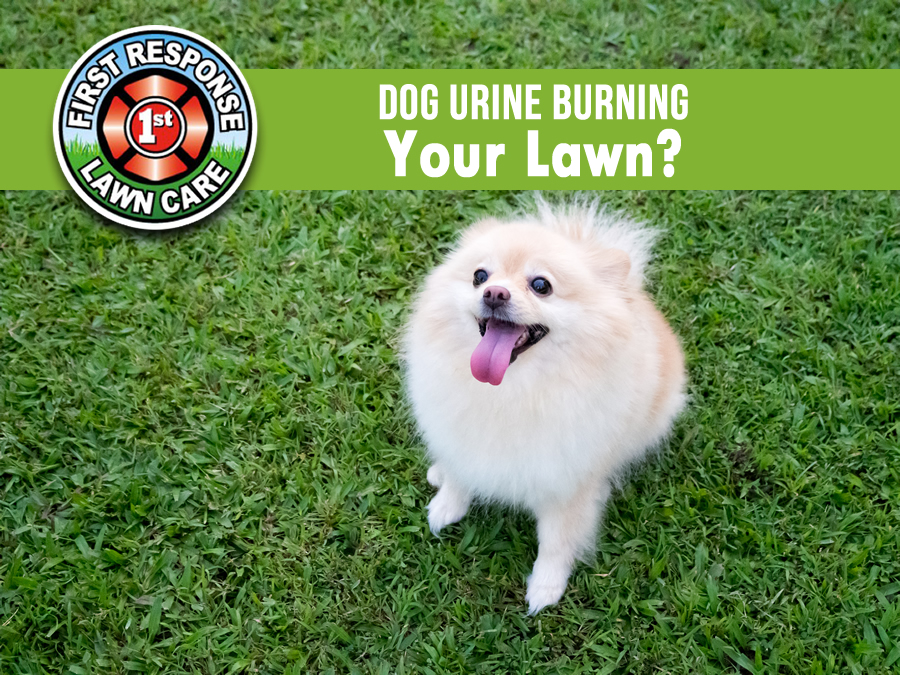
by admin | Jul 7, 2017 | Lawn Care 101, Lawn Care Royse City, Lawn Maintenance Rockwall, Pet Urine Damage on Lawn
We love our dogs. What we do not love is the side effect of dog urine on our lawns. You know what we mean – those unsightly brown “burn” spots on the lawn. They make the yard unsightly and seem impossible to get rid of. And if like us, you have multiple dogs, you can quickly find yourself with a dead lawn.
How can dog urine turn your lawn brown?
Because dogs eat a high level of protein in their diet, they break the protein down and excrete it as nitrogen in their urine. The result unfortunately, can kill your lawn. You will get the same kind of burn if you put a concentrated handful of fertilizer in one spot. However, it’s interesting to note that not all dog’s urine does this, which is a mystery.
Is there anything you can do to protect your lawn from dog urine?
Here’s some advice on what pet owners can do to protect their lawn and keep their pet healthy and happy.
- Use a leash to control where your dog urinates.
- Water the lawn right after your dog urinates to dilute the nitrogen on the grass.
- Dilute your dog’s urine by encouraging them to drink more water.
- Try a different high quality dog food. Do not switch your dog’s food to a low quality, low protein food just to save your lawn. There are other ways that will not compromise your dog’s health.
- Do not put fertilizer on your burned lawn to try and bring it back. Fertilizer’s are also high in nitrogen, so you will just speed up the killing.
There is no real way to remove the spots once they are there. In fact, as mentioned above, trying to use a fertilizer to get your grass to grow back will actually make it worse. It is best to just wait until the grass comes back on its own.






